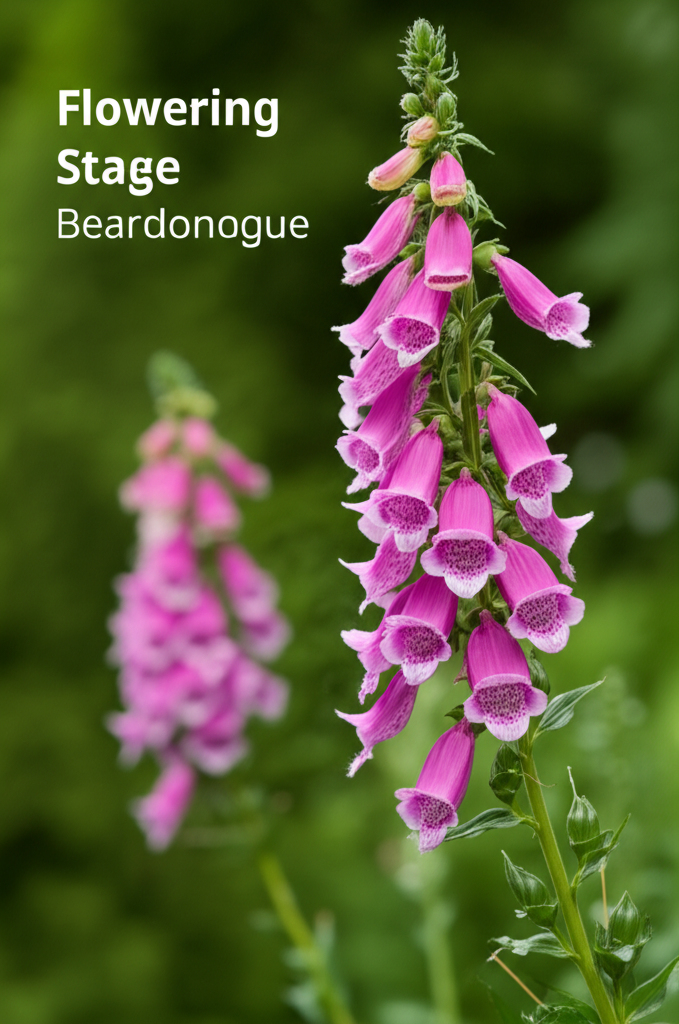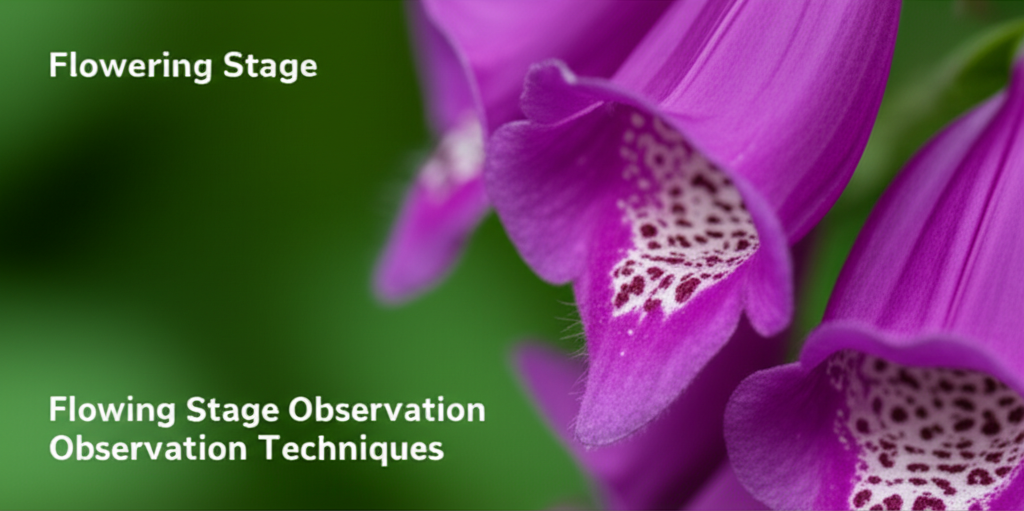Introduction to Foxglove Beardtongue (Penstemon digitalis)
Foxglove Beardtongue, scientifically known as Penstemon digitalis, is a captivating native perennial that graces meadows, prairies, and garden borders with its elegant spires of tubular, often white or pale lavender flowers. Belonging to the Plantaginaceae family, this hardy and adaptable plant is a favorite among gardeners and a vital resource for pollinators, particularly bumblebees and other native bees. Understanding the nuances of its flowering stages is crucial for accurate botanical surveys, ecological studies, and successful horticultural practices. This article delves into comprehensive observation techniques, guiding you through the distinct phases of Foxglove Beardtongue’s bloom cycle, from bud formation to seed dispersal, highlighting key characteristics for identification and assessment.
The Importance of Observing Flowering Stages

Observing the flowering stages of Penstemon digitalis offers a wealth of information. For botanists and ecologists, these observations are vital for:
- Phenological Studies: Tracking the timing of flowering events provides insights into plant-environment interactions, climate change impacts, and shifts in ecosystem dynamics.
- Pollinator Interactions: The flowering period directly influences the availability of nectar and pollen for a wide range of insects, understanding these stages helps assess the plant’s role in supporting local biodiversity.
- Population Monitoring: Observing flowering success can indicate the health and reproductive potential of a Penstemon digitalis population.
For gardeners and horticulturalists, understanding these stages facilitates:
- Optimal Planting and Care: Knowing when a plant will bloom aids in planning garden layouts and anticipating maintenance needs.
- Seed Collection: Identifying the precise stage for seed maturity ensures the collection of viable seeds for propagation.
- Aesthetic Enjoyment: Appreciating the plant’s life cycle enhances the gardening experience.
Key Stages of Foxglove Beardtongue Flowering
Foxglove Beardtongue exhibits a predictable, yet subtly variable, progression through its reproductive cycle. The following breakdown details the primary stages, providing observable characteristics for each.
1. Vegetative Growth and Bud Formation
Prior to flowering, Penstemon digitalis dedicates its energy to developing robust foliage and preparing for reproduction.
Characteristics to Observe:
- Foliage Development: Look for the emergence of basal rosettes and the elongation of upright stems. The leaves are typically lanceolate to oblong, smooth-edged or finely toothed, and a vibrant green.
- Stem Elongation: The flowering stems will begin to lengthen, reaching their mature height, which can range from 2 to 4 feet (0.6 to 1.2 meters).
- Inflorescence Initiation: At the apex of the stems, you will notice the gradual development of the terminal panicle or raceme. Initially, these will appear as tight clusters of small, undeveloped flower buds.
- Bud Appearance: The individual buds are small, often green or tinged with purple, and tightly enclosed within protective sepals.
2. Bud Swell and Pre-Bloom
This stage signifies that the plant is nearing its reproductive prime, with flower buds becoming more prominent and showing the first hints of color.
Characteristics to Observe:
- Bud Swelling: The individual buds will visibly enlarge, becoming plumper and more distinct.
- Coloration: A faint blush of color, often pale pink, lavender, or white, will begin to appear on the buds. The degree of coloration can vary significantly between cultivars and individual plants.
- Sepals Opening Slightly: The sepals, which enclose the bud, may begin to separate slightly, revealing the developing petals within.
- Inflorescence Structure: The overall structure of the inflorescence becomes more defined, with a clear arrangement of potential flowers along the stem.
3. Early Bloom (Anthesis)
This is the initial phase of flowering where the first flowers in the inflorescence begin to open.
Characteristics to Observe:
- First Open Flowers: Typically, the lowest flowers on the inflorescence will be the first to open.
- Flower Shape: Each flower is tubular, with a prominent, bearded lower lip (hence “Beardtongue”). The upper lip is typically two-lobed, and the lower lip is three-lobed. The “beard” refers to small, fuzzy hairs often found inside the throat of the flower.
- Color Intensity: The color of the petals will be more pronounced, ranging from pure white to various shades of pink and lavender.
- Stamen and Pistil Visibility: The reproductive parts, including the stamens with their anthers and the pistil with its stigma, will become visible as the flower opens.
- Fragrance: Some varieties may exhibit a subtle fragrance during this stage.
4. Peak Bloom
This is the most visually striking stage, characterized by a profusion of fully open flowers throughout the inflorescence.
Characteristics to Observe:
- Widespread Flowering: A significant percentage of the flowers on the inflorescence will be open and fully developed.
- Full Color Saturation: The colors of the petals will be at their most vibrant.
- Pollinator Activity: This stage typically coincides with the highest levels of pollinator visitation. Observe which insects are attracted and their behavior.
- Flower Longevity: Individual flowers will typically remain open for several days, but the overall bloom period of the plant is sustained by new flowers opening sequentially.
5. Late Bloom and Developing Fruits
As the peak bloom wanes, some flowers begin to fade, while others transition into the fruit development stage.
Characteristics to Observe:
- Fading Flowers: Petals may begin to wither, lose their color, and droop.
- Seed Pod Formation: The ovary at the base of the flower begins to swell and develop into a seed capsule. Initially, these pods are green and fleshy.
- Continued Pollinator Activity: While peak activity may have passed, some pollinators may still visit the remaining open flowers.
- Bract Development: The leafy structures (bracts) subtending the flowers and flower clusters may remain prominent.
6. Seed Maturation and Dispersal
In this final stage, the seed pods mature and eventually split open to release their seeds.
Characteristics to Observe:
- Seed Pod Ripening: The seed capsules turn brown and dry. They will become brittle and may show signs of splitting.
- Seed Release: The capsules typically dehisce (split open) along a suture, releasing numerous small seeds. Wind can play a significant role in seed dispersal.
- Foliage Senescence: The foliage may start to yellow and die back as the plant prepares for dormancy, although some evergreen foliage may persist in milder climates.
- Persistent Seed Heads: Dried flower stalks and seed heads can remain standing through winter, providing visual interest and habitat for overwintering insects.
Observation Techniques and Tools
Effective observation relies on a systematic approach and the right tools.
Phenological Data Collection Methods
Visual Inspection:
Regular visual checks of the plants are fundamental. This involves walking through the population or garden and noting the presence and abundance of flowers at different stages.
Photography:
Documenting the plant’s progression with photographs at consistent intervals (e.g., weekly) provides a valuable visual record for analysis and comparison.
Marking and Tagging:
For detailed studies, individual plants or specific flower stalks can be marked with tags to track their development precisely.
Field Guides and Resources:
Utilize reputable field guides and botanical keys to confirm identification and understand specific regional variations.
Tools for Detailed Observation
- Hand Lens (10x-20x magnification): Essential for examining the intricate details of flower structure, the “beard” hairs, and the development of reproductive parts.
- Notebook and Pen/Pencil: For recording dates, observations, and measurements. Waterproof notebooks are ideal for field use.
- GPS Device or App: To record the precise location of observed plants for mapping and repeat visits.
- Camera: For photographic documentation.
- Pruning Shears or Small Knife: For carefully collecting samples if permitted and necessary for detailed examination under magnification.
Factors Influencing Flowering Stages
Several environmental and biological factors can influence the timing and duration of Penstemon digitalis flowering.
Environmental Factors
Temperature:
Warmer spring temperatures generally accelerate bud development and flowering, while cooler springs can delay these processes. Frost events can also impact early-blooming flowers.
Sunlight:
Full sun exposure is generally preferred by Foxglove Beardtongue and promotes robust flowering. Shaded conditions can lead to leggier growth and reduced bloom intensity.
Moisture Availability:
Adequate soil moisture, particularly during the critical stages of bud formation and flowering, is crucial. Drought stress can lead to premature wilting and reduced flowering success.
Soil Conditions:
Well-drained soil is essential. While Penstemon digitalis is adaptable to various soil types, nutrient availability can influence overall plant vigor and bloom production.
Biological Factors
Genetics and Cultivar:
Different species of Penstemon and even different cultivars of Penstemon digitalis can have inherent variations in their flowering times and durations.
Plant Age and Vigor:
Younger plants may take longer to establish and may have less prolific flowering than mature, vigorous specimens.
Competition:
Competition from surrounding plants for light, water, and nutrients can affect the growth and flowering of Penstemon digitalis.
Pollinator Activity:
While not directly influencing the timing of the stage itself, the presence and activity of pollinators are critical for successful fertilization and subsequent seed development.
Key Facts and Comparison Table
Here’s a table summarizing crucial aspects of Penstemon digitalis flowering:
| Characteristic | Description | Typical Observation Period (Region Dependent) | Significance |
|---|---|---|---|
| Scientific Name | Penstemon digitalis | N/A | Accurate identification. |
| Common Name | Foxglove Beardtongue, White Beardtongue | N/A | Common reference. |
| Flower Color | White to pale lavender/pink | N/A | Visual identification, aesthetic appeal. |
| Inflorescence Type | Terminal panicle or raceme | N/A | Floral structure observation. |
| Bud Stage | Tight, small buds, often green/purple-tinged | Late Spring | Precedes flowering. |
| Early Bloom | First flowers open at the base of the inflorescence | Late Spring to Early Summer | Initial flowering period. |
| Peak Bloom | Majority of flowers open and fully developed | Early to Mid-Summer | Maximum visual impact, peak pollinator activity. |
| Late Bloom | Some flowers fading, seed pods forming | Mid to Late Summer | Transition to seed production. |
| Seed Dispersal | Brown, dry seed capsules split open | Late Summer to Fall | Reproduction and propagation. |
| Pollinator Attraction | Bumblebees, native bees, butterflies | Throughout flowering stages | Ecological importance. |
Pros and Cons of Different Observation Focuses
When observing Penstemon digitalis, different focuses can yield varying levels of detail and utility.
| Focus Area | Pros | Cons |
|---|---|---|
| Overall Bloom Period | Provides a general understanding of the plant’s presence and resource availability for pollinators. Easy to monitor for broad ecological surveys. | Lacks detailed insight into specific flower development or pollinator interactions at finer scales. |
| Individual Flower Development (Anthesis) | Allows for detailed study of pollination mechanisms, nectar production, and flower longevity. Crucial for research on specific pollinator relationships. | Time-consuming and requires precise timing and potentially marking individual flowers. May miss the overall impact of the population’s bloom. |
| Seed Pod Maturation and Dispersal | Essential for understanding reproductive success, seed viability, and the plant’s ability to self-propagate. Important for conservation and propagation efforts. | Requires observation during later stages, which may be less visually striking. Seed dispersal can be rapid and difficult to track precisely. |
| Pollinator Visitation Rates | Directly measures the plant’s ecological function as a food source. Provides data on pollinator communities and their activity patterns. | Requires specialized knowledge of insect identification and observation techniques. Weather-dependent and can be affected by other floral resources in the area. |
Conclusion: Mastering the Art of Observation
The observation of Foxglove Beardtongue’s flowering stages is a rewarding endeavor that connects us with the intricate cycles of nature. By employing systematic observation techniques, utilizing appropriate tools, and understanding the environmental factors that influence its bloom, we can gain a deeper appreciation for this valuable native plant. Whether for scientific inquiry, conservation efforts, or simply the joy of gardening, mastering these observation techniques unlocks a richer understanding of Penstemon digitalis and its vital role in our ecosystems. Consistent and detailed observation contributes to a growing body of knowledge that can inform future horticultural practices and ecological management strategies, ensuring the continued beauty and ecological significance of Foxglove Beardtongue.


